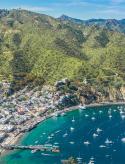A century ago, a man fell in love with an island. That love affair lasted for the rest of his life and became a legacy he passed on to his descendants. Thanks to that enduring passion, a community was fostered, a unique ecosystem was protected and a seaside resort was promoted to the entire country.
The man was William Wrigley, Jr. and the island was Santa Catalina.
In 1919, Wrigley, flush with success – and cash – purchased Santa Catalina Island. Initially an investor, Wrigley quickly determined he wanted a more active role in determining the island’s destiny and he became the sole proprietor of nearly all of the island.
When Wrigley purchased Catalina Island, it was still recovering from a devastating fire that had destroyed nearly all of Avalon. The chewing gum entrepreneur set to work developing attractions, creating infrastructure and increasing the island’s visibility.
Much of what Wrigley built during his lifetime has become intricately entwined with the island’s culture: the Catalina Island Casino is recognized around the world as an Island icon; the Catalina Country Club, initially the clubhouse for Wrigley’s Chicago Cubs, has seen millions of visitors over the years and Mt. Ada, the home Wrigley built, continues to perch over Avalon and today welcomes hundreds of visitors each year as an exclusive bed and breakfast.
This summer, another of William Wrigley, Jr.’s projects will reopen. The Hotel Atwater originally opened in 1920 and was named for his daughter-in-law, Helen Atwater. After a multi-million-dollar renovation, the hotel will begin serving guests once again, along with a new restaurant, PKW, named for his son, Philip Knight Wrigley.
As visible as his influence is, it may be what visitors don’t see that has had an even greater impact on the island. Wrigley created housing, invested in utilities and forged industries, all of which were the foundation of a thriving community that supports the tourism that made Catalina famous.
Making Catalina Island famous was another of Wrigley’s legacies, one he approached with tenacity, creativity and cohesion. Thanks to an enduring partnership with legendary designers Dorothy and Otis Shepard, Wrigley put Catalina Island on the minds of Americans from coast to coast with clever images and compelling copy. He also used intriguing events – like an open ocean swim race to the island with a generous purse -- to capture the imagination of the public and the attention of the press. Wrigley also used his other assets – and passions – to promote the island: for nearly 30 years Wrigley’s Chicago Cubs help spring training in Avalon, a tradition that brought national attention to the seaside community.
Perhaps Wrigley’s most enduring legacy is Catalina itself. While Wrigley experimented with several options for the vast interior of the island, his descendants took the definitive step to protect it in perpetuity, granting nearly 90 percent of Catalina Island to the Catalina Island Conservancy, which is charged with preserving and protecting the island for future generations.
Ways to learn more about Wrigley’s legacy on Catalina Island.
Visit the Catalina Island Museum.
Take a tour: Visit landmarks such as the Catalina Country Club, Mt. Ada, the Catalina Island Casino, the former Avalon Bird Park and more.
Visit the Wrigley Memorial and Botanic Garden: Nestled high above Avalon at the top of Avalon Canyon Road, the Wrigley Memorial stands as an enduring monument to the man whose vision shaped Avalon and protected Catalina Island.

